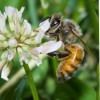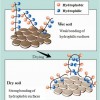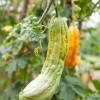
The jalapeño is derived from the Capsicum genus of the family Solanaceae. Jalapeños are members of a diverse group, which also include ancho poblano, cayenne, serrano, Anaheim, banana, Asian, habanero, and Hungarian wax peppers. Hot peppers are classified by their heat and shape. The heat of the pepper comes from the chemical compound capsaicin, which is measured by the Scoville scale. This 8-page fact sheet is a guide of jalapeño and other hot pepper varieties used in Florida was written by Monica Ozores-Hampton and Gene McAvoy, and published by the UF Department of Horticultural Sciences, October 2014.
http://edis.ifas.ufl.edu/hs1241
Tag: Eugene McAvoy
Minimizing Honey Bee Exposure to Pesticides
 Protecting honey bees and other pollinators from pesticide impacts is important to the sustainability of agriculture. Consequently, pesticide applicators must determine if there is a clear hazard to managed or wild populations of bees. Potential exposure of bees to pesticides can vary greatly depending on the type of pesticide, formulation, application method, label restrictions, and other factors. The goal in using a pesticide is to achieve maximum benefit (success) with minimum negative impact, and these factors should always be considered in pesticide selection. This publication is written (1) to help assure the sustainability of both bees and agriculture by informing beekeepers, pesticide users, and the general public about the often complex relationship between pollinators (specifically bees) and pesticides, (2) to offer guidance for improved communication between beekeepers and pesticide users, (3) to offer pollinator risk-reducing strategies for growers and other applicators when using pesticides, and (4) to provide clarity in laws, labeling, and associated definitions. This 14-page fact sheet was written by J. D. Ellis, J. Klopchin, E. Buss, F. M. Fishel, W. H. Kern, C. Mannion, E. McAvoy, L. S. Osborne, M. Rogers, M. Sanford, H. Smith, P. Stansly, L. Stelinski, and S. Webb, and published by the UF Department of Entomology and Nematology, March 2014.
Protecting honey bees and other pollinators from pesticide impacts is important to the sustainability of agriculture. Consequently, pesticide applicators must determine if there is a clear hazard to managed or wild populations of bees. Potential exposure of bees to pesticides can vary greatly depending on the type of pesticide, formulation, application method, label restrictions, and other factors. The goal in using a pesticide is to achieve maximum benefit (success) with minimum negative impact, and these factors should always be considered in pesticide selection. This publication is written (1) to help assure the sustainability of both bees and agriculture by informing beekeepers, pesticide users, and the general public about the often complex relationship between pollinators (specifically bees) and pesticides, (2) to offer guidance for improved communication between beekeepers and pesticide users, (3) to offer pollinator risk-reducing strategies for growers and other applicators when using pesticides, and (4) to provide clarity in laws, labeling, and associated definitions. This 14-page fact sheet was written by J. D. Ellis, J. Klopchin, E. Buss, F. M. Fishel, W. H. Kern, C. Mannion, E. McAvoy, L. S. Osborne, M. Rogers, M. Sanford, H. Smith, P. Stansly, L. Stelinski, and S. Webb, and published by the UF Department of Entomology and Nematology, March 2014.
http://edis.ifas.ufl.edu/in1027
Application of Surfactants in Commercial Crop Production for Water and Nutrient Management in Sandy Soil
 Water-repellent soils are unable to effectively adsorb or retain water. On these soils, water may simply pool on the surface or may move down preferred pathways, leaving large amounts of soil dry even when a large volume of water is applied. Thus, managing water and nutrients in sandy soils is often challenging. This 6-page fact sheet provides an overview of surfactants and how they may be used to better manage water and nutrients in sandy soils for vegetable and fruit production. Written by Guodong Liu, Monica Ozores-Hampton, Gene McAvoy, Ben Hogue, and Crystal A. Snodgrass, and published by the UF Department of Horticultural Sciences, October 2013.
Water-repellent soils are unable to effectively adsorb or retain water. On these soils, water may simply pool on the surface or may move down preferred pathways, leaving large amounts of soil dry even when a large volume of water is applied. Thus, managing water and nutrients in sandy soils is often challenging. This 6-page fact sheet provides an overview of surfactants and how they may be used to better manage water and nutrients in sandy soils for vegetable and fruit production. Written by Guodong Liu, Monica Ozores-Hampton, Gene McAvoy, Ben Hogue, and Crystal A. Snodgrass, and published by the UF Department of Horticultural Sciences, October 2013.
http://edis.ifas.ufl.edu/hs1230
Diseases of Bitter Melon in South Florida (PP300)
 Bitter melon, a tropical and subtropical cucurbit, is widely grown in Asia, Africa, and the Caribbean for its edible fruit. Rich in vitamins A and C, iron, and phosphorus, it contains a compound (charantin) that has been used to lower blood sugar levels to treat diabetes. Two major types of bitter melon, Chinese and Indian, are grown in South Florida year-round. This publication describes common diseases and provides recommendations for their control. This 3-page fact sheet was written by Shouan Zhang, Mary Lamberts, and Gene McAvoy, and published by the UF Department of Plant Pathology, October 2012.
Bitter melon, a tropical and subtropical cucurbit, is widely grown in Asia, Africa, and the Caribbean for its edible fruit. Rich in vitamins A and C, iron, and phosphorus, it contains a compound (charantin) that has been used to lower blood sugar levels to treat diabetes. Two major types of bitter melon, Chinese and Indian, are grown in South Florida year-round. This publication describes common diseases and provides recommendations for their control. This 3-page fact sheet was written by Shouan Zhang, Mary Lamberts, and Gene McAvoy, and published by the UF Department of Plant Pathology, October 2012.
http://edis.ifas.ufl.edu/pp300
Blossom Drop, Reduced Fruit Set, and Post-Pollination Disorders in Tomato (HS1195)
 Blossom drop and reduced fruit set in tomato can seriously impact yields. Growers in Florida routinely experience such problems and inquire about the cause and possible preventative measures to reduce flower loss and improve yields. The problem can be frustrating and difficult to manage in some situations. This 6-page fact sheet was written by Monica Ozores-Hampton, Fnu Kiran, and Gene McAvoy, and published by the UF Department of Horticultural Sciences, July 2012.
Blossom drop and reduced fruit set in tomato can seriously impact yields. Growers in Florida routinely experience such problems and inquire about the cause and possible preventative measures to reduce flower loss and improve yields. The problem can be frustrating and difficult to manage in some situations. This 6-page fact sheet was written by Monica Ozores-Hampton, Fnu Kiran, and Gene McAvoy, and published by the UF Department of Horticultural Sciences, July 2012.
http://edis.ifas.ufl.edu/hs1195
How to Reduce Clogging Problems in Fertigation (HS1202)
 Fertigation is the process of applying fertilizers through an irrigation system by injecting them into the water. Because of its effectiveness and efficiency, fertigation is widely used in vegetable and fruit production. However, clogging of lines and emitters may become a problem. This 7-page fact sheet provides practical suggestions for better fertigation management so growers can reduce clogging problems. Written by Guodong Liu and Gene McAvoy, and published by the UF Department of Horticultural Sciences, June 2012.
Fertigation is the process of applying fertilizers through an irrigation system by injecting them into the water. Because of its effectiveness and efficiency, fertigation is widely used in vegetable and fruit production. However, clogging of lines and emitters may become a problem. This 7-page fact sheet provides practical suggestions for better fertigation management so growers can reduce clogging problems. Written by Guodong Liu and Gene McAvoy, and published by the UF Department of Horticultural Sciences, June 2012.
http://edis.ifas.ufl.edu/hs1202
Managing Thrips and Tospoviruses in Tomato (ENY859/IN895)
 Several invasive species of thrips have established in Florida and are causing serious economic losses to vegetable, ornamental, and agronomic crops. Damage to crops results from thrips feeding and egg-laying injury, by the thrips vectoring of plant diseases, the cost of using control tactics, and the loss of pesticides due to resistance. This 12-page fact sheet describes the biology and ecology of thrips and tomato spotted wilt virus, and recommends a management program. Written by Joe Funderburk, Stuart Reitz, Steve Olson, Phil Stansly, Hugh Smith, Gene McAvoy, Ozan Demirozer, Crystal Snodgrass, Mathews Paret, and Norm Leppla, and published by the UF Department of Entomology and Nematology, August 2011.
Several invasive species of thrips have established in Florida and are causing serious economic losses to vegetable, ornamental, and agronomic crops. Damage to crops results from thrips feeding and egg-laying injury, by the thrips vectoring of plant diseases, the cost of using control tactics, and the loss of pesticides due to resistance. This 12-page fact sheet describes the biology and ecology of thrips and tomato spotted wilt virus, and recommends a management program. Written by Joe Funderburk, Stuart Reitz, Steve Olson, Phil Stansly, Hugh Smith, Gene McAvoy, Ozan Demirozer, Crystal Snodgrass, Mathews Paret, and Norm Leppla, and published by the UF Department of Entomology and Nematology, August 2011.
http://edis.ifas.ufl.edu/in895
Groundnut Ringspot Virus in Florida (PP282)
 Groundnut ringspot virus was recently identified in tomatoes in South Florida — the first report in the United States. It can infect tomato plants at all stages of growth and lead to unmarketable fruits or plant death. This 4-page fact sheet shares what is known about the symptoms, host range, disease transmission, and management. Written by Eugene McAvoy, Scott Adkins, Craig Webster, Charles Mellinger, Loren Horsman, Galen Frantz, Stuart Reitz, and Shouan Zhang, and published by the UF Department of Plant Pathology, July 2011.
Groundnut ringspot virus was recently identified in tomatoes in South Florida — the first report in the United States. It can infect tomato plants at all stages of growth and lead to unmarketable fruits or plant death. This 4-page fact sheet shares what is known about the symptoms, host range, disease transmission, and management. Written by Eugene McAvoy, Scott Adkins, Craig Webster, Charles Mellinger, Loren Horsman, Galen Frantz, Stuart Reitz, and Shouan Zhang, and published by the UF Department of Plant Pathology, July 2011.
http://edis.ifas.ufl.edu/pp282
Recommendations for Management of Whiteflies, Whitefly-transmitted viruses, and Insecticide Resistance for Production of Cucurbit Crops in Florida (EENY478/IN871)
 Until recently, squash has been the only cucurbit crop seriously affected by the B biotype of the sweetpotato whitefly, also known as the silverleaf whitefly, because of the silverleaf disorder induced by feeding of the immature stages (nymphs). However, three viruses transmitted by the whitefly have been identified in watermelon, muskmelon, and squash in Florida since 2004, making whitefly management a priority for most cucurbits. This 8-page fact sheet details the current UF/IFAS recommendations for managing whitefly-transmitted viruses and for delaying the development of resistance to insecticides in the whitefly vector. Published by the UF Department of Entomology and Nematology, July 2011.
Until recently, squash has been the only cucurbit crop seriously affected by the B biotype of the sweetpotato whitefly, also known as the silverleaf whitefly, because of the silverleaf disorder induced by feeding of the immature stages (nymphs). However, three viruses transmitted by the whitefly have been identified in watermelon, muskmelon, and squash in Florida since 2004, making whitefly management a priority for most cucurbits. This 8-page fact sheet details the current UF/IFAS recommendations for managing whitefly-transmitted viruses and for delaying the development of resistance to insecticides in the whitefly vector. Published by the UF Department of Entomology and Nematology, July 2011.
http://edis.ifas.ufl.edu/in871
Tomato Varieties for Florida: Florida ‘Red Rounds,’ Plum, Cherries, and Grapes (HS1189)
Tomatoes were introduced to European culture more than a hundred years before Linnaeus developed the binomial system of naming plants. After a brief discussion of the scientific naming of tomato and tomato varieties, the tables in this 13-page fact sheet provide a guide to varieties used in Florida listing the companies selling each, growing season, characteristics of plant and fruit, disease resistance, and other comments, separated by regional adaptation. Written by Monica Ozores-Hampton, Gene McAvoy, Stephen Olson, Kent Cushman, and Nancy Roe , and published by the UF Department of Horticultural Sciences, March 2011.
http://edis.ifas.ufl.edu/hs1189
AE462 Aplicabilidad del Pronóstico de Variabilidad Climática Estacional: El Manejo de Riesgos en la Producción del Tomate en el sur del Estado de Florida
AE462, a 9-page illustrated fact sheet by Norman Breuer, Clyde Fraisse, Gene McAvoy and David Letson, is the Spanish language version of “CIR1450/AE269 Using Seasonal Climate Variability Forecasts: Risk Management for Tomato Production in South Florida.” It describes the difference between weather and climate, suggests climate-based management options available to tomato growers, and discusses economic and risk management implications of seasonal climate variability for tomato producers and extensionists in South Florida. Includes references. Published by the UF Department of Agricultural and Biological Engineering, May 2010.
http://edis.ifas.ufl.edu/ae462
FE817 Production Budget for Tomatoes in the Manatee-Ruskin Area of Florida
FE817, a 6-page fact sheet by John VanSickle, Scott Smith, and Eugene McAvoy, highlights tomato production in the Manatee-Ruskin Area, with a per-acre composite budget for a representative grower. Includes references. Published by the UF Department of Food and Resource Economics, December 2009.
http://edis.ifas.ufl.edu/FE817
FE810 Production Budget for Bell Peppers in Southwest Florida
FE810, a 4-page fact sheet by John VanSickle, Scott Smith, and Eugene McAvoy, provides an overview of bell pepper production practices for Southwest Florida producers, including a per-acre composite budget breaking down the specific cost components. Includes references. Published by the UF Department of Food and Resource Economics, December 2009.
http://edis.ifas.ufl.edu/FE810
FE809 Production Budget for Bell Peppers in Palm Beach County, Florida
FE809, a 4-page fact sheet by John VanSickle, Scott Smith, and Eugene McAvoy, provides an overview of bell pepper production practices for Palm Beach County producers, including a per-acre composite budget breaking down the specific cost components. Includes references. Published by the UF Department of Food and Resource Economics, December 2009.
http://edis.ifas.ufl.edu/FE809
FE818 Production Budget for Tomatoes in Southwest Florida
FE818, a 5-page fact sheet by John VanSickle, Scott Smith, and Eugene McAvoy, provides producers with brief overview of tomato industry and production practices in southwest Florida, with a per-acre composite budget for a representative grower. Includes references. Published by the UF Department of Food and Resource Economics, December 2009.
http://edis.ifas.ufl.edu/FE818